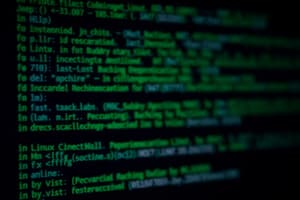Podcast
Questions and Answers
What does the 'ls -li' command do in Linux?
What does the 'ls -li' command do in Linux?
Lists files with their inode numbers.
What are the different types of file links in Linux? (Select all that apply)
What are the different types of file links in Linux? (Select all that apply)
- -: Ordinary file (correct)
- l: Symbolic link (correct)
- c: Character-oriented devices
- d: Directory (correct)
- b: Block-oriented devices
Explain the difference between 'su' and 'sudo' in Linux.
Explain the difference between 'su' and 'sudo' in Linux.
su requires root user password, while sudo runs a single command with root privileges.
What command is used to add users to the sudoers file in Linux? vi /etc________
What command is used to add users to the sudoers file in Linux? vi /etc________
Shell scripts in Linux are written in binary format.
Shell scripts in Linux are written in binary format.
What is the purpose of a shell script in Linux?
What is the purpose of a shell script in Linux?
What percentage of the world's top one million servers run on Linux?
What percentage of the world's top one million servers run on Linux?
Why is Linux preferred for Data Science & Data Analytics?
Why is Linux preferred for Data Science & Data Analytics?
Match the following Linux distributions with their names:
Match the following Linux distributions with their names:
Linux is invulnerable and virus-free.
Linux is invulnerable and virus-free.
Linux is a ____, not an operating system.
Linux is a ____, not an operating system.
Flashcards are hidden until you start studying
Study Notes
Here are the study notes:
Introduction to Linux
- Linux is an operating system that is used in various applications, including space programs, servers, and personal finance management.
- It is used by 96.3% of the world's top one million servers and 90% of the public cloud workload.
- Linux is a multi-user, multitasking, stable, and secure operating system.
History of Linux
- Linux was created by Linus Torvalds in 1991.
- The first version of Linux was released in 1991, and it was initially released under a license that forbade commercial use.
- In 1992, the license was changed to the GNU General Public License (GPL).
Linux and Unix
- Unix was developed in 1969 by a group of AT&T employees, including Ken Thompson, Dennis Ritchie, and Brian Kernighan.
- Unix was initially written in assembly language, but it was rewritten in C in 1973.
- Linux was created as a Unix-like operating system, but it is not a Unix derivative.
Open Source Software
- Open source software is software that is freely available and can be modified and redistributed.
- The GNU General Public License (GPL) is a free software license that ensures that software remains free and open-source.
- The GPL has four essential freedoms:
- The freedom to use the software for any purpose.
- The freedom to change the software to suit your needs.
- The freedom to share the software with your friends and neighbors.
- The freedom to share the changes you make to the software.
Linux Distribution
- A Linux distribution is a collection of software packages that are bundled together to make it easy to install and use Linux.
- Popular Linux distributions include Ubuntu, Fedora, Red Hat Enterprise Linux, and Debian GNU/Linux.
- Linux distributions can be categorized into three types:
- Debian-based distributions (e.g., Ubuntu, Debian GNU/Linux)
- Red Hat-based distributions (e.g., Red Hat Enterprise Linux, CentOS)
- Arch Linux and its derivatives (e.g., Arch Linux, Manjaro)
Linux Architecture
- The Linux architecture consists of the kernel, system libraries, and system utilities.
- The kernel is the core of the Linux operating system, and it manages the system's hardware resources.
- System libraries provide a way for system utilities to interact with the kernel.
Linux Filesystem
- The Linux filesystem is a hierarchical structure that consists of a root directory (/) and several subdirectories.
- The root directory contains essential system files, including the kernel, system libraries, and system utilities.
- The /bin directory contains essential command binaries, and the /sbin directory contains essential system binaries.
Linux Commands
- Basic Linux commands include:
- cd (change directory)
- ls (list files and directories)
- pwd (print working directory)
- mkdir (make a directory)
- rm (remove a file or directory)
- cat (concatenate and display files)
- More advanced Linux commands include:
- sudo (run a command with superuser privileges)
- su (switch to a different user)
- type (display the type of a command)
- tree (display a directory tree)
Linux Shells
- A shell is a command-line interface that allows users to interact with the operating system.
- Popular Linux shells include:
- Bash (GNU Bourne-Again Shell)
- Csh (C Shell)
- Ksh (Korn Shell)
- Tcsh (Tenex C Shell)
- Shells provide a way to execute commands, navigate the filesystem, and manage processes.
Linux Security
- Linux security involves protecting the system from unauthorized access and malicious attacks.
- Firewalls are used to block unauthorized access to the system, and they can be configured using tools like iptables and firewalld.
- Packet filtering is a technique used to block or allow incoming and outgoing network packets based on certain criteria.
I hope this helps! Let me know if you have any questions or need further clarification.
Studying That Suits You
Use AI to generate personalized quizzes and flashcards to suit your learning preferences.




